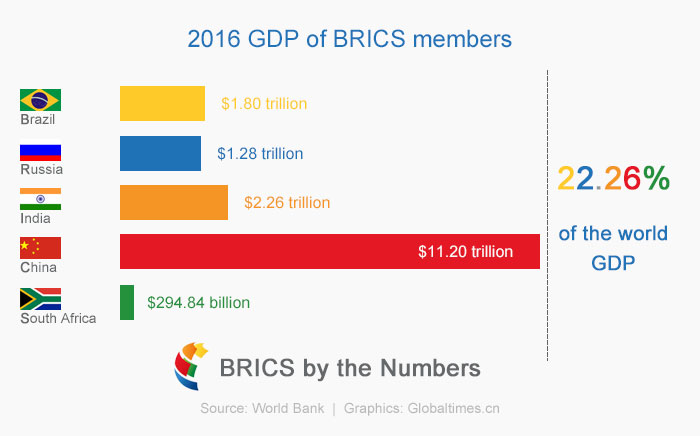STANDING TALL AT BRICS
July 2, 2022 | Expert Insights

The five-member BRICS (Brazil, Russia, India, China, and South Africa) held its 14th Summit in Beijing in June, just before the G7 summit scheduled in Germany. Since India was a participant in both (as an observer in the G7), it was important for the latter to fine-tune its geopolitical stance at the BRICS under the shadow of the war in Ukraine before it mingled with the richest seven nations of the globe.
Background
The BRIC acronym was coined by Goldman Sachs Chief Economist Jim O'Neill in 2001. With the coming together of emerging economies that were not part of the exclusive G7 club, it was hoped that an alternative to the western dominated economic sphere could be brought about. In his 2001 paper titled “Building Better Global Economics BRICS”, Jim O’Neill had made a case for greater representation in global governance by these four (later joined by South Africa) emerging economies. However, two decades later, his opinion was much tempered by the harsh realities of global geoeconomics. In a pawer written last year, he bemoaned the inability of the bloc to develop substantive policies despite its annual summits. "While the first decade was a roaring success for all four countries, with each surpassing all four scenarios that I originally outlined, the second decade was less kind to Brazil and Russia, whose respective shares of global GDP have now fallen back to where they were 20 years ago," anguished Jim O'Neill. "If it weren’t for China – and India, to some degree – there wouldn’t be much of a BRIC story to tell.”

Analysis
On the ground, the BRICS countries had a great deal to show in the first decade of the existence of the group; from less than 20 per cent to more than 30 per cent growth in the world GDP (Gross Domestic Product), they stunned the world. However, the monetary crisis that emerged later with all the turmoil in the global economy sank the BRICS ship; only China and India could maintain a straight course while Russia, Brazil and South Africa floundered.
This year’s BRICS summit was dominated by discussions on the aftermath of the Ukraine war. Russia was keen to widen the opportunities for its isolated economy with its BRICS co-members. The only way Russian sanctions can be eased is if the BRICS allows substantial trade with Russia.
President Putin emphasised Russia’s national interest by inviting FDI (Foreign Direct Investment) and increasing trade with major economic powers within BRICS. In a press release, he also stated that 'despite western sanctions, the BRICS trade circle has shown a positive response to grow significantly across borders.' However, with the threat of secondary sanctions against countries continuing to expand trade with Russia, especially in crude oil, gathering momentum in the West, the BRICS members will step forward with a great deal of prudence.
Beijing echoed the concerns of Moscow when it spoke of military expansion (not directly naming NATO or Russia) and gave a gentle reminder of looming wars in the future. However, it would be ironic for India to listen to China's warning of expansion when the latter is doing the same on India's Himalayan Frontiers.
The Indian Prime Minister followed a script that had been fine-tuned during the last QUAD meeting, laying emphasis on recovery in a post-pandemic world, and the Indian focus on a free, open, inclusive, and rules-based maritime space; respect for sovereignty and territorial integrity of all nations from the Indian Ocean Region to the Pacific Ocean; and reform of multilateral system as large parts of Asia and all of Africa and Latin America have no voice in global decision-making. The criticism from China seems to have had no effect on India as it totally ignored the current Russia Ukraine crisis. India emphasised more on recovering from the post-pandemic situation and stated that BRICS could be an engine for global growth. This was the stand India would follow for sure in the G7, too, to avoid picking any sides.
Countries like Algeria, Argentina, Cambodia, Egypt, Ethiopia, Fiji, Indonesia, Iran, Kazakhstan, Malaysia, Senegal, Thailand, and Uzbekistan were the participant members in the summit. Argentina and Iran showed positive signs of joining BRICS brigs which raised the question of whether BRICS could prove to be a ‘knight in the shining armour' in post-covid recovery for several other economies?
Whether BRICS is a success or a failure remains a matter of debate. However, India's attempt to divert attention from Ukraine to collaboration in improving the global economy in the post-pandemic world and strengthening the BRICS identity was evident. India proposed the establishment of an Online Database for BRICS documents, the BRICS Railways Research Network, and increasing cooperation between MSMEs.
Assessment
- The neutrality that India chose will eventually benefit India in the long term, without antagonising Russia or the U.S. India's national interest lie in trying to advocate the recovery from the post-covid situations by boosting trade across boundaries, including India and the other smaller nations.
- India participating as a special guest at the G7 soon after the BRICS summit, and a similar stand can be expected there; staying neutral between the two powers and, talking more on global recovery in the post-pandemic world and encouraging multilateral ties in increasing global understanding and more of advancements in technology in improving the world.








Comments